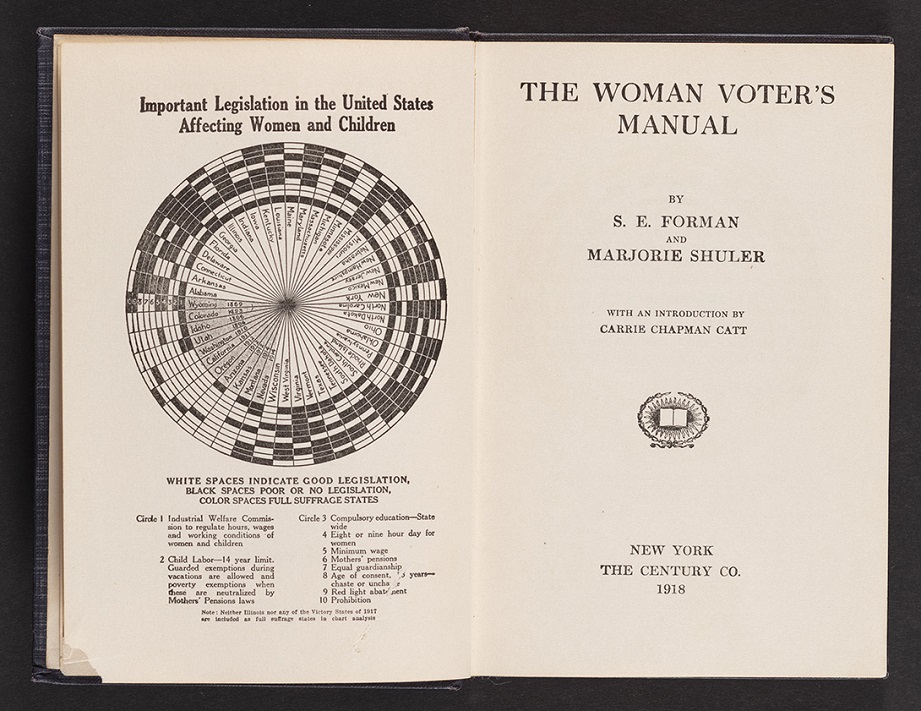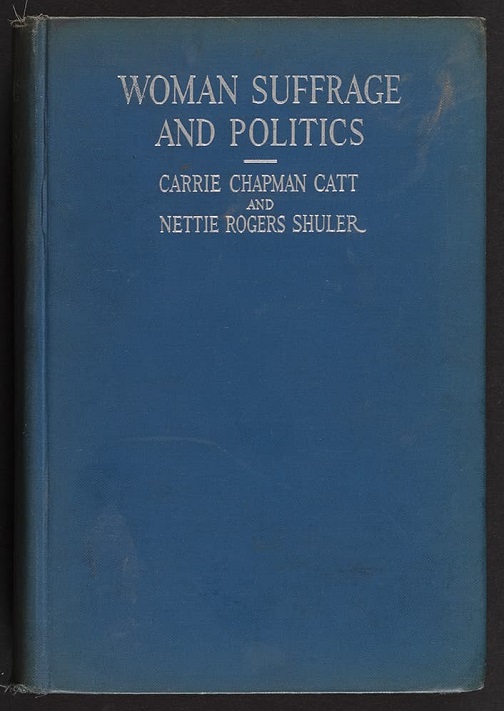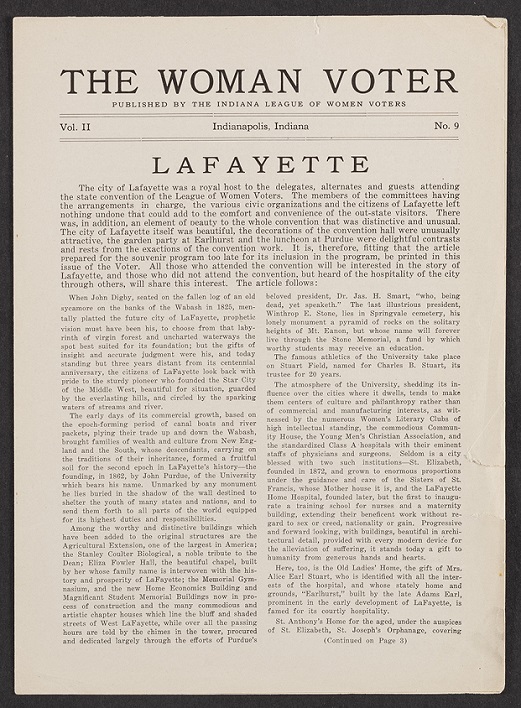
Educating New Voters
In anticipation of the amendment’s passing, leaders of the National American Woman
Suffrage Association (NAWSA) debated the future of their organization. They voted to
dissolve NAWSA and endorse the League of Women Voters with the mission of educating
women for their inevitable citizenship. Carrie Chapman Catt, president of NAWSA and an
integral player in securing the passage of the 19th Amendment, became the first president
of the new national organization. Local and state chapters began forming across the
United States to assist with the League’s mission of educating the new electorate.
On November 2, 1920, Hoosier women, and many women across the country, cast their
ballots in the presidential election for the first time. Voter turnout in Indiana
was overwhelming, with early women voters outnumbering men in many cities.
Suffrage Association (NAWSA) debated the future of their organization. They voted to
dissolve NAWSA and endorse the League of Women Voters with the mission of educating
women for their inevitable citizenship. Carrie Chapman Catt, president of NAWSA and an
integral player in securing the passage of the 19th Amendment, became the first president
of the new national organization. Local and state chapters began forming across the
United States to assist with the League’s mission of educating the new electorate.
On November 2, 1920, Hoosier women, and many women across the country, cast their
ballots in the presidential election for the first time. Voter turnout in Indiana
was overwhelming, with early women voters outnumbering men in many cities.

Educating New Voters


Woman suffrage and politics: the inner
story of the suffrage movement, 1923
General Rare Collection, 324.3 C29
Description
story of the suffrage movement, 1923
General Rare Collection, 324.3 C29
Description
Both containing writings by Catts, The woman voter’s manual aims to stimulate women’s desire
to learn about government; whereas Woman suffrage and politics contextualizes the suffrage
movement and discusses the struggles of engaging in American politics.
to learn about government; whereas Woman suffrage and politics contextualizes the suffrage
movement and discusses the struggles of engaging in American politics.

Educating New Voters
Women’s organizations in Lafayette focused on educating the newly enfranchised voters.
The Three O’clock Club, aptly named due to the timing of their meetings, is a local women's
organization founded in 1894 that still meets today and is focused on the intellectual
advancement of their members. On January 26, 1920, just four days after Indiana ratified
the 19th Amendment, they held their regular meeting with a discussion on “what women
need to know about the ballot.”
The Three O’clock Club, aptly named due to the timing of their meetings, is a local women's
organization founded in 1894 that still meets today and is focused on the intellectual
advancement of their members. On January 26, 1920, just four days after Indiana ratified
the 19th Amendment, they held their regular meeting with a discussion on “what women
need to know about the ballot.”

Educating New Voters

Pamphlet listing discussion topics, 1919-1921
Three O'clock Club records, 20190520, Box 1
Description
Three O'clock Club records, 20190520, Box 1
Description
A pamphlet from the Three O’clock Club listing the discussion topics for their meetings.

Educating New Voters

"Citizenship school held here April 17", April 13, 1923
Purdue Exponent Collection, volume 34, number 167
Description | Digital Image
Purdue Exponent Collection, volume 34, number 167
Description | Digital Image
A newspaper article from the Purdue Exponent
discussing the newly established citizenship
schools at Purdue.
discussing the newly established citizenship
schools at Purdue.

Educating New Voters
In April 1920, Lafayette women formed a local chapter of the League of Women
Voters and the following year, the League of Women Voters of Indiana formed.
The State League began disseminating information to its membership through its
newsletter, "The Woman Voter," and began a statewide citizen education campaign
that same year. The State League held conventions for its membership, which they
still do today, to plan legislative work, educational campaigns, and stay accountable
to their membership. They held their third annual convention in Lafayette with the
luncheon at Purdue.
Voters and the following year, the League of Women Voters of Indiana formed.
The State League began disseminating information to its membership through its
newsletter, "The Woman Voter," and began a statewide citizen education campaign
that same year. The State League held conventions for its membership, which they
still do today, to plan legislative work, educational campaigns, and stay accountable
to their membership. They held their third annual convention in Lafayette with the
luncheon at Purdue.

Educating New Voters

The Indiana League of Women Voters Third Annual Convention, 1922
League of Women Voters of Greater Lafayette records, MSP 55, Box 1, Folder 3
Description
League of Women Voters of Greater Lafayette records, MSP 55, Box 1, Folder 3
Description
The program for the third annual convention
of the Indiana League of Women Voters which
includes the schedule and details about the
speakers and facilities for the convention,
which was held in Lafayette, Indiana.
of the Indiana League of Women Voters which
includes the schedule and details about the
speakers and facilities for the convention,
which was held in Lafayette, Indiana.

Educating New Voters

"The Woman Voter," volume 2, number 6, April 15, 1922
League of Women Voters of Greater Lafayette records, MSP 55, Box 1, Folder 3
Description
League of Women Voters of Greater Lafayette records, MSP 55, Box 1, Folder 3
Description
An article in "The Woman Voter" detailing plans for the third annual state convention, held in
Lafayette with a luncheon on Purdue’s campus. This luncheon was held at Ladies Hall where
members discussed the formation of citizenship schools to be held at Purdue the following year.
Lafayette with a luncheon on Purdue’s campus. This luncheon was held at Ladies Hall where
members discussed the formation of citizenship schools to be held at Purdue the following year.

Educating New Voters

"The Woman Voter," volume 2, number 9, 1922
League of Women Voters of Greater Lafayette records, MSP 55, Box 1, Folder 3
Description
League of Women Voters of Greater Lafayette records, MSP 55, Box 1, Folder 3
Description
An article printed in "The Woman Voter"
after the third annual convention of the
Indiana League of Women Voters, describing
attendees’ experience in Lafayette, its
history, and the city. The article includes
mentions of Columbian Park, the Fowler’s house,
now Fowler House Mansion, and Fort Ouiatenon.
after the third annual convention of the
Indiana League of Women Voters, describing
attendees’ experience in Lafayette, its
history, and the city. The article includes
mentions of Columbian Park, the Fowler’s house,
now Fowler House Mansion, and Fort Ouiatenon.